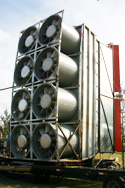Home > Pruning shade trees > Pruning reduces wind damage > Videos of trees blowing
Videos of trees blowing after pruned in different manners
 |
 |
Pruning is the best method to reduce storm damage to trees, and the best method of reducing damage caused by trees.
We conducted several studies on the impact of pruning methods on potential tree damage in storms. The results are shown in the videos below.
No pruning: Here is a live oak tree with a 6 inch trunk diameter about 20 feet tall that was not pruned. Notice how much the main trunk is moving left to right in a 75 to 90 mph wind. Watch video
Reducing the crown: Here is a live oak tree about 20 feet tall pruned by reducing its height using a reduction cut back to a lateral branch. Although this is not an appropriate method of pruning trees of this small size, it would be appropriate to shorten a branch (or several branches) of this size on a much larger tree. This is a good method of reducing likelihood of tree failure in strong wind. Notice how much less the main trunk is moving left to right in 75 to 90 mph wind compared to the tree that was not pruned shown in the accompanying video above. Watch video.
Thinning the crown: Here is a live oak tree pruned by thinning the crown by removing branches 1-2 inches in diameter back to the trunk. Although in many cases this is not necessary on trees of this small size, it would be appropriate to thin the largest branches (or several branches) of this size on a much larger tree. This is a good method of reducing likelihood of tree failure in strong wind. Notice how much less the main trunk is moving left to right in 75 to 90 mph wind compared to the tree that was not pruned shown in the accompanying video above. Thinning should occur on the outer edge of the tree crown - in other words, lower and interior branches should not be removed. Watch video.

